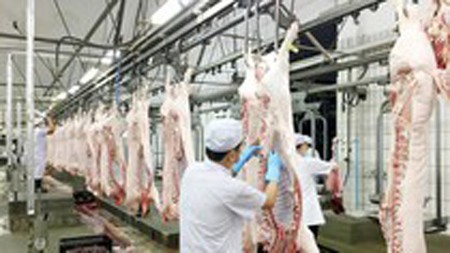
Lately, to actively control the domestic pork supply in the city and prevent possible market shocks due to the outbreak of African swine fever, related agencies in HCMC have supported businesses and distribution systems to increase importing pork from approved nations.
In the first six months of this year, 6,000 tons of pork worth US$10.29 million has been imported into Vietnam, a rise of nearly 4,800 tonnes compared to the same period last year.
The Ministry of Agriculture and Rural Development announced the 24 approved countries for pork and pork product import, consisting of Australia, Austria, Belgium, Brazil, Canada, Germany, Hungary, India, Ireland, Italy, Japan, the Republic of Korea, Holland, New Zealand, Spain, Poland, the US, Russia, Mexico.
However, all this imported produce needs careful inspection and quarantine procedures before entering Vietnam.
Mr. Nguyen Phuong Dong, Deputy Director of the municipal Department of Industry and Trade, affirmed that pork prices in the market is still quite stable until July 2019. In particular, the prices of live pigs type 1 and type 2 are VND35,000 and VND40,000 per kilo (approx. $1.5 and $1.7) respectively.
A closer look at the market shows that the consumption output in traditional markets is witnessing a slight decrease as buyers are concerned over the safety of pork sold here. Nevertheless, more modern selling channels like supermarkets are experiencing a strong growth. A representative of Saigon Co.op shared that the pork consumption output in the system saw a 30 percent increase, plus a 10-15 percent rise of poultry since this is an ideal alternative with stable prices.
The HCMC Department of Industry and Trade also reported a surplus amount of imported pork with a reasonable imported price of VND30,000 ($1.3) per kilo, a bit lower than the one of domestic produce. It normally takes 45 to 60 days from placing an order to selling pork in retail shops.
To avoid any unsteadiness in the market, since July many methods have been simultaneously applied to closely monitor the market and implement the price stabilization program while building a close supply chain and encouraging pig quantity increase in farms.
Suppliers are also suggested to buy and then freeze more pork to timely answer the market demands whenever there is a sign of insufficiency.
At present, many leading pork businesses in HCMC are actively importing and storing this produce in case of potential instability in the near future.
























